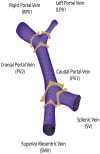Fat mitigation strategies to improve image quality of radial 4D flow MRI in obese subjects
- PMID: 37036023
- PMCID: PMC10231668
- DOI: 10.1002/mrm.29652
Fat mitigation strategies to improve image quality of radial 4D flow MRI in obese subjects
Abstract
Purpose: This study addresses the challenges in obtaining abdominal 4D flow MRI of obese patients. We aimed to evaluate spectral saturation and inner volume excitation as methods to mitigating artifacts originating from adipose signals, with the goal of enhancing image quality and improving quantification.
Methods: Radial 4D flow MRI acquisitions with fat mitigation (inner volume excitation [IVE] and intermittent fat saturation [FS]) were compared to a standard slab selective excitation (SSE) in a test-retest study of 15 obese participants. IVE selectively excited a cylindrical region of interest, avoiding contamination from peripheral adipose tissue, while FS globally suppressed fat based on spectral selection. Acquisitions were evaluated qualitatively based on expert ratings and quantitatively based on conservation of mass, test-retest repeatability, and a divergence free quality metric. Errors were evaluated statistically using the absolute and relative errors, regression, and Bland-Altman analysis.
Results: IVE demonstrated superior performance quantitatively in the conservation of mass analysis in the portal vein, with higher correlation and lower bias in regression analysis. IVE also produced flow fields with the lowest divergence error and was rated best in overall image quality, delineating small vessels, and producing the least streaking artifacts. Evaluation results did not differ significantly between FS and SSE. Test-retest reproducibility was similarly high for all sequences, with data suggesting biological variations dominate the technical variability.
Conclusion: IVE improved hemodynamic assessment of radial 4D flow MRI in the abdomen of obese participants while FS did not lead to significant improvements in image quality or flow metrics.
© 2023 The Authors. Magnetic Resonance in Medicine published by Wiley Periodicals LLC on behalf of International Society for Magnetic Resonance in Medicine.
Figures










Similar articles
-
Hemodynamic measurements with an abdominal 4D flow MRI sequence with spiral sampling and compressed sensing in patients with chronic liver disease.J Magn Reson Imaging. 2019 Apr;49(4):994-1005. doi: 10.1002/jmri.26305. Epub 2018 Oct 14. J Magn Reson Imaging. 2019. PMID: 30318674 Free PMC article.
-
Free-breathing 3-D quantification of infant body composition and hepatic fat using a stack-of-radial magnetic resonance imaging technique.Pediatr Radiol. 2019 Jun;49(7):876-888. doi: 10.1007/s00247-019-04384-7. Epub 2019 Apr 17. Pediatr Radiol. 2019. PMID: 31001664
-
Improved vessel-tissue contrast and image quality in 3D radial sampling-based 4D-MRI.J Appl Clin Med Phys. 2017 Nov;18(6):250-257. doi: 10.1002/acm2.12194. Epub 2017 Oct 4. J Appl Clin Med Phys. 2017. PMID: 28980395 Free PMC article.
-
Clinical Applications of 4D Flow MRI in the Portal Venous System.Magn Reson Med Sci. 2022 Mar 1;21(2):340-353. doi: 10.2463/mrms.rev.2021-0105. Epub 2022 Jan 25. Magn Reson Med Sci. 2022. PMID: 35082218 Free PMC article. Review.
-
4D Flow MRI in the portal venous system: imaging and analysis methods, and clinical applications.Radiol Med. 2022 Nov;127(11):1181-1198. doi: 10.1007/s11547-022-01553-x. Epub 2022 Sep 19. Radiol Med. 2022. PMID: 36123520 Free PMC article. Review.
References
Publication types
MeSH terms
Grants and funding
LinkOut - more resources
Full Text Sources
Medical

